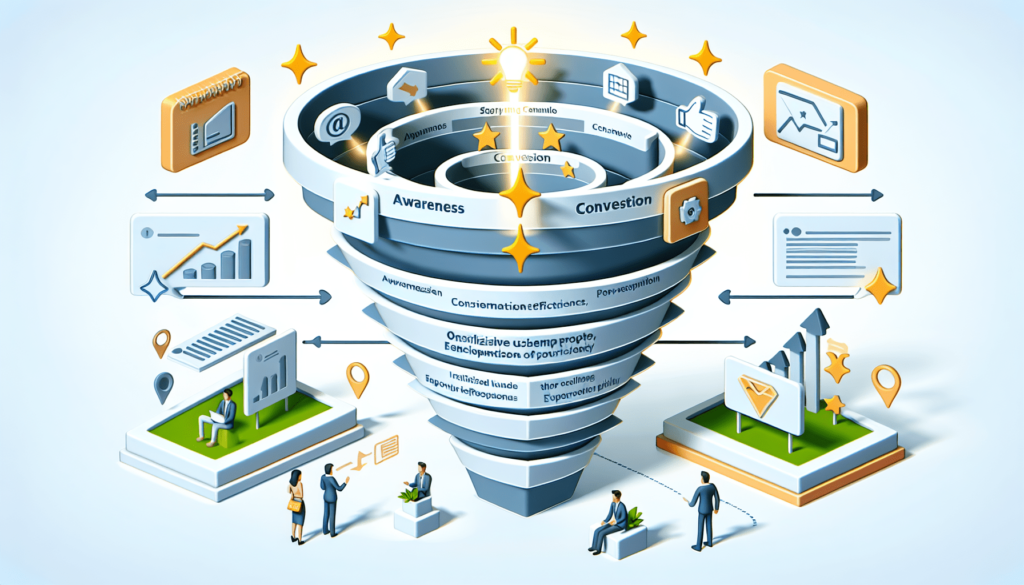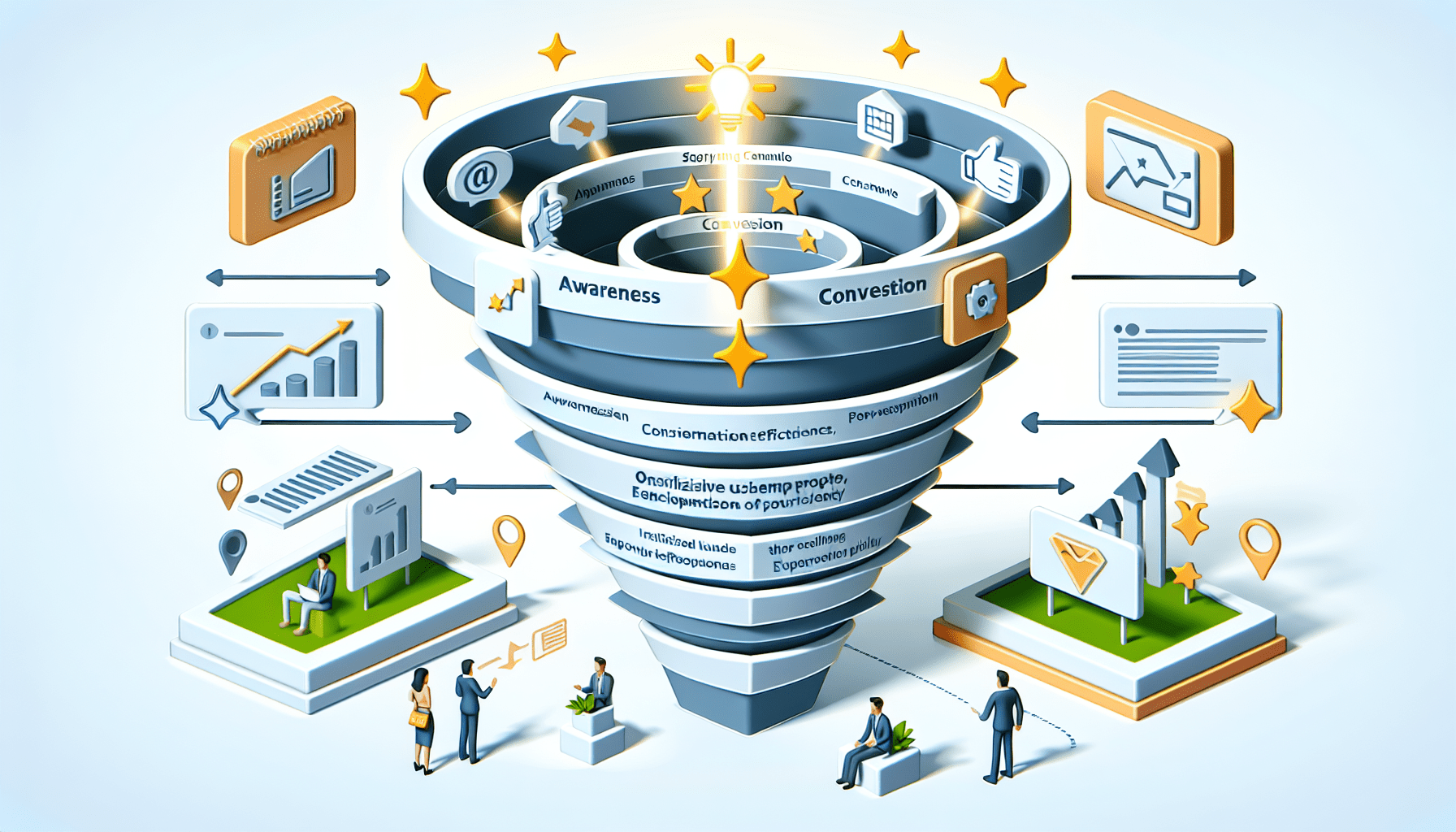Are you struggling to convert leads into customers? If so, you’re not alone. Many businesses face the challenge of optimizing their marketing funnel to increase conversion rates. In this article, we will explore various strategies that can help you improve your funnel’s conversion rate. Whether it’s enhancing your landing page design, implementing persuasive copywriting techniques, or leveraging social proof, we’ve got you covered. Get ready to learn actionable tips that will take your conversion rates to new heights.

Improving the Website User Experience
In order to improve the user experience on your website, there are several strategies you can implement. Optimizing the page load time is essential, as slow-loading pages can lead to frustration and increased bounce rates. By reducing the size of images, minifying code, and utilizing caching techniques, you can significantly improve the speed at which your pages load.
Another important aspect of website user experience is streamlining the navigation. Make sure your menu is clear and easy to navigate, with logical categories and subcategories. Additionally, consider implementing a search function to allow users to easily find what they are looking for.
With the increasing use of mobile devices, it is imperative to implement responsive design on your website. Responsive design ensures that your site adapts to different screen sizes and resolutions, providing a seamless experience for mobile users. This includes using flexible layouts, optimizing images for mobile, and ensuring that buttons and links are easily clickable on smaller screens.
Furthermore, enhancing the mobile experience goes beyond responsive design. It’s important to take into account the specific needs and behaviors of mobile users. For example, consider implementing mobile-friendly forms and checkout processes, as well as optimizing the placement of important elements on mobile screens.
Creating Compelling Call-to-Actions
A compelling call-to-action (CTA) is crucial in prompting your visitors to take the desired action on your website. First and foremost, using clear and persuasive language is key to a successful CTA. Make sure your CTA clearly conveys the value proposition and encourages visitors to take action.
Equally important is the strategic placement of your CTAs. Position them prominently on your website, using eye-catching design and strategic placement. For example, placing CTAs above-the-fold or at the end of compelling content can increase their visibility and effectiveness.
Designing visually appealing buttons can also make a significant difference in your conversion rates. Use contrasting colors, attention-grabbing graphics, and well-designed typography to make your CTAs stand out. This will capture the attention of your visitors and entice them to click.
Lastly, utilizing urgency and scarcity in your CTAs can create a sense of urgency and encourage immediate action. This can be done by using phrases like “limited time offer” or “only 2 left in stock.” By creating a sense of scarcity, you can compel visitors to take action before they miss out.
Leveraging Social Proof
Social proof is a powerful psychological phenomenon that can greatly influence people’s purchasing decisions. Displaying customer testimonials is a great way to showcase the positive experiences others have had with your products or services. Ensure that the testimonials are genuine and include specific details to make them more convincing.
Highlighting case studies allows potential customers to see real-life examples of how your product or service has solved problems and delivered results. Case studies should include detailed descriptions of the challenge, the solution, and the outcome, in order to demonstrate your expertise and credibility.
Including positive reviews from reputable sources or popular review platforms can further enhance social proof. These reviews can serve as an unbiased endorsement of your products or services, helping potential customers feel more comfortable and confident in their decision to purchase.
Showcasing user-generated content is another effective way to leverage social proof. This can include customer photos, videos, or testimonials shared on social media or through your website. By highlighting how other customers are engaging with your brand, you can create a sense of community and authenticity.
Implementing A/B Testing
A/B testing, also known as split testing, is a process of comparing two versions of a webpage or marketing element to determine which one performs better. This approach allows you to systematically test different elements and make data-driven decisions to optimize your conversions.
Testing different headlines is a common practice in A/B testing. The headline is often the first thing visitors see, so experimenting with different variations can have a significant impact on engagement and conversion rates. Test different wording, tone, and messaging to see what resonates most with your audience.
Varying layout and design elements can also be explored through A/B testing. This includes testing different color schemes, button sizes, font choices, and overall design aesthetic. Small changes in design can sometimes lead to significant improvements in conversion rates.
Experimenting with pricing strategies is another aspect of A/B testing that can yield valuable insights. By testing different pricing options, such as discounts, free trials, or bundling, you can determine the optimal pricing strategy that motivates visitors to convert.
Trying different colors and visuals is yet another element that can be tested through A/B testing. The psychological impact of color and visual elements on human behavior is well-documented, and choosing the right colors and visuals can help create the desired emotional response and influence conversion rates.

Personalizing the Customer Journey
Segmenting your audience allows you to tailor your marketing efforts and website experience to specific demographics or characteristics. By understanding the different needs and preferences of your audience segments, you can create personalized experiences that resonate with each group.
Tailoring content to specific demographics involves creating targeted messages and offers based on factors such as age, gender, location, or past behavior. By providing content that is relevant and valuable to each segment, you increase the likelihood of engagement and conversion.
Using dynamic email marketing allows you to send personalized emails to subscribers based on their individual preferences and behaviors. By analyzing data such as past purchases, browsing history, or email interactions, you can deliver tailored content and offers that align with each subscriber’s interests and preferences.
Providing personalized recommendations is another effective way to personalize the customer journey. By analyzing user behavior and purchase history, you can offer product recommendations that are likely to resonate with each individual. This not only enhances the user experience but can also lead to increased sales and customer satisfaction.
Improving the Offer
Adding value through bonuses or extras is a great way to make your offer more compelling. By including additional products, services, or resources as bonuses, you can create a sense of increased value and incentivize potential customers to make a purchase.
Offering discounts or promotions can also be an effective strategy to increase conversions. Everyone loves a good deal, and by providing a limited-time discount or a special promotion, you create a sense of urgency and encourage visitors to take advantage of the offer before it expires.
Providing free shipping or returns can also go a long way in increasing conversions. Shipping costs and concerns about returning a product can be major deterrents for potential customers. By eliminating these barriers, you remove potential obstacles and make the decision to purchase much easier.
Creating limited-time offers can create a sense of urgency and prompt immediate action. By clearly communicating that the offer is only available for a limited time, you encourage visitors to make a decision sooner rather than later. This can increase conversions and prevent potential customers from procrastinating or forgetting about the offer.
Optimizing Landing Pages
Ensuring message match with ad campaigns is crucial for maintaining consistency and relevance. When visitors arrive at your landing page after clicking on an ad, the messaging and design should align with what was promised in the ad. This provides a seamless experience and ensures that visitors are not confused or disappointed.
Streamlining the content and removing distractions is another important factor in optimizing landing pages. Your landing page should have a clear and concise message that focuses on the key benefits and features of your product or service. Minimize distractions such as excessive text, unnecessary links, or irrelevant images that can divert visitors’ attention.
Including compelling headlines and subheadings can help captivate your audience and keep them engaged. Use compelling and benefit-driven headlines that clearly communicate the value proposition of your offering. Subheadings can further break down the information and guide visitors through the content.
Including clear and concise form fields is essential for optimizing landing pages. The form should only ask for the necessary information needed to complete the desired action. Long and complicated forms can be a major deterrent and lead to a high abandonment rate. Make it easy for visitors to convert by keeping the form simple and user-friendly.
Implementing Live Chat Support
Providing real-time assistance to visitors through live chat support can greatly enhance the user experience and increase conversions. Live chat allows visitors to ask questions, get immediate answers, and receive personalized recommendations, all within the context of your website.
Addressing concerns and objections in real-time is a significant advantage of live chat support. Visitors who have reservations or doubts about making a purchase can have their concerns addressed directly and in a timely manner. This can help alleviate any doubts or hesitations and increase the likelihood of conversion.
Offering personalized recommendations through live chat support can further enhance the user experience and increase conversions. By analyzing the visitor’s behavior and preferences, you can provide tailored recommendations and guide them towards the products or services that best meet their needs.
Building trust and rapport through live chat support is another benefit. The ability to have a real-time conversation with a knowledgeable representative can help establish credibility and trust with your potential customers. This can play a significant role in their decision to make a purchase.
Streamlining the Checkout Process
Reducing the number of form fields in the checkout process is crucial to preventing cart abandonment. Asking for excessive information can be tiresome and time-consuming for customers. By only asking for the necessary information, such as shipping address and payment details, you can streamline the checkout process and make it more efficient.
Offering a guest checkout option is another way to streamline the checkout process and increase conversions. Forcing customers to create an account can be a major barrier, especially for first-time visitors. By allowing guest checkout, you remove an unnecessary step and make it easier for visitors to complete their purchase.
Implementing multiple payment options is essential to accommodate the preferences and needs of different customers. Some customers may prefer to pay with a credit card, while others may prefer to use PayPal or other digital wallets. By providing multiple payment options, you remove any obstacles and allow customers to choose the method that is most convenient for them.
Displaying progress indicators throughout the checkout process can help ease the customer’s anxiety and provide a sense of control. By clearly indicating the steps involved and how far along the customer is in the process, you can increase confidence and reduce abandonment rates.
Analyzing Data and Metrics
Setting up conversion tracking is essential to measure the effectiveness of your marketing efforts and identify areas for improvement. Conversion tracking allows you to track specific actions, such as purchases, clicks, or sign-ups, and attribute them to the specific marketing campaigns or channels that drove them.
Analyzing website analytics provides valuable insights into how visitors are interacting with your website. By analyzing metrics such as page views, bounce rates, and time on site, you can identify areas of improvement and optimize the user experience. This data can help you understand which pages are performing well and which ones may need adjustments.
Evaluating conversion funnels allows you to identify potential bottlenecks or areas of drop-off in the customer journey. By carefully analyzing each step in the conversion funnel, you can identify where visitors are dropping off and take steps to address those issues. This can lead to increased conversions and a more efficient customer journey.
Using heatmaps and user recordings can provide valuable visual insights into how visitors are interacting with your website. Heatmaps show you where visitors are clicking or scrolling the most, while user recordings allow you to watch how individual visitors navigate through your website. This information can help you identify patterns, pain points, and areas of improvement to optimize the user experience.
In conclusion, by implementing these strategies to improve the website user experience, creating compelling call-to-actions, leveraging social proof, implementing A/B testing, personalizing the customer journey, improving the offer, optimizing landing pages, implementing live chat support, streamlining the checkout process, and analyzing data and metrics, you can greatly increase your funnel’s conversion rate and drive more success for your online business.

